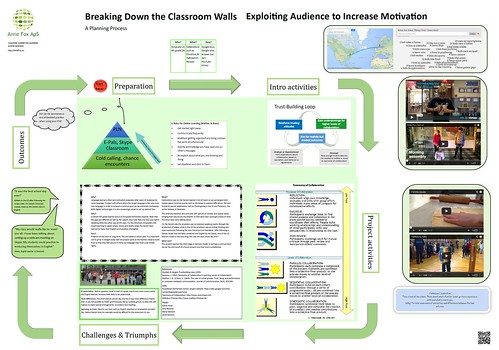Conversation between me, Anne and Amy Musone, a third grade teacher at York Elementary School in Pennsylvania on the topic of a global collaboration between Amy’s students and a 6th grade class at my local school.
Anne: I have initiated and collaborated on several very different global collaborations over the years, ever since pre-Internet days. Amy, working with you over the last couple of years, I knew that you were a very innovative and hard-working educator open to new ideas and I remembered hearing you mention that you were up for opening up your classroom walls so you were an obvious choice for a global collaboration.
Here in Denmark, I approached a local school I have worked with before with the idea of an international collaboration. For the Danish school the motivation was the opportunity to interact with native English speakers as there is increasing emphasis on the importance of learning English here. I think they got more than they bargained for in that area in fact! But maybe we can pick up on that point later. So Amy why did you say yes to this collaboration?
Amy: You ask, why did you say yes to this collaboration? Besides the obvious reason of the global connection, which I will address in a bit, is that I would have an extended opportunity to work with you. Having you as a coaching mentor last year gave me first-hand experience of what could be in regards to global collaboration. I consider you a close colleague, someone who I can trust, someone who is non-judgemental, and someone who lives halfway around the world! After experiencing that, how could I pass up the opportunity to extend that possibility to eight & nine year olds.
There are other reasons that I jumped in with both feet. In working with you, I realized how limited my understanding of other cultures actually is. My assumptions were proved inaccurate as I learned a bit about how schooling in Denmark is different than schooling in America. Also learned that terminology is used a bit differently (i.e.: administrator). Those kinds of things were a wake up call for me. If I operated in this limited view of the world, would it be much different for my learners?
Another reason for taking on this project is that it would provide authentic learning experiences that incorporated learning standards. This experience would be sticky. The kids will remember this much more than they would a traditional lesson.
My hope is that this collaboration will continue next year. Mrs. Reinholt, my partner teacher, has been so giving of her time and resources. She and her older learners have provided us with many interesting and unique learning experiences.
Anne: Joint projects can be tightly organised or organic. I would call this one organic Can you tell us a little about the overall theme and perhaps you could give a few examples of some of those sticky activities?
Amy: Anne, would agree here with the project being organic. Our original plan of action was so much smaller than what the final product is turning out to be. The sharing between the schools has become quite contagious. Pictures and text became movies, recipes, ebooks, and care packages. The Danes shared a recipe with our class for pepper nut cookies. They made a video of how to make the cookies and sent a recipe that was translated into English. We made the cookies, posted what we did on Twitter, and created a Twitter story using Storify. The Danes, then took those pictures and remixed them. They shared the story of how we made the cookies in Danish. This is one of many examples of how the learners engaged with one another and the content that was shared.
Anne: I must say that from the Danish end we wondered if the age difference might be an issue, the Danes were 6th graders and yours are 3rd graders. Another issue we wondered about was whether the young Danes would be able to understand fast-talking native speakers.
Amy: There was an age difference, but it didn’t seem visible, at least from my perspective.
We had to learn how to communicate with English learners. We spoke quickly and made assumptions. We had to be mindful of our audience and practice speaking at a slower pace and using concise language. Being aware of this was important, but sometimes difficult to gauge. Were we talking clear enough? Were we talking a just right pace? Questions that we (my class) continue to ask ourselves as we work through the projects associated with this pairing.
Focusing on audience and purpose in a project like this is paramount.
Anne: So what I’m hearing from you, Amy, is that there was deep engagement. As the project unfolded during our work within this community we began to wonder how much it aligned to the three E’s of Inspired Education and how it would need to change to further align to the Inspired Education Framework.
Let’s end by hearing what some of Amy’s students had to say.
I think it’s awesome that we get to connect with other people from around the world and what they do in life and at school. ~Deanna
It’s cool because we actually get to learn what other people do and how they talk. ~Will
I think it’s fun because we get to learn new things about different people around the world. ~Ava
I think it’s cool that we get to learn about each others’ holidays and share how we celebrate them. ~ Kara
It’s really fun that we get to send each other recipes and gifts back and forth. ~Emily
Here’s an example of the sharing that occurred between the learners: https://sites.google.com/site/connectingkidsdenusa/fastelavn
And here is how Anne presented the power of collaboration at the 2014 IATEFL conference in Harrogate, UK (Click to enlarge).
References
http://nodaybuttoday-musone.blogspot.dk/2013/12/christmas-cookies-from-halfway-around.html
https://sites.google.com/site/connectingkidsdenusa/home


